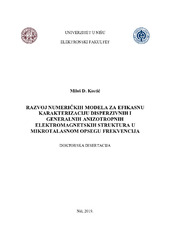Приказ основних података о дисертацији
Razvoj numeričkih modela za efikasnu kakaterizaciju disperzivnih i generalnih anizotropnih elektromagnetskih struktura u mikrotalasnom opsegu frekvencija
| dc.contributor.advisor | Dončov, Nebojša S. | |
| dc.contributor.other | Marković, Vera | |
| dc.contributor.other | Maleš-Ilić, Nataša | |
| dc.contributor.other | Stevanović, Marija | |
| dc.contributor.other | Stanković, Zoran Ž. | |
| dc.creator | Kostić, Miloš D. | |
| dc.date.accessioned | 2020-08-06T11:11:00Z | |
| dc.date.available | 2020-08-06T11:11:00Z | |
| dc.date.issued | 2019-12-24 | |
| dc.identifier.uri | http://eteze.ni.ac.rs/application/showtheses?thesesId=7336 | |
| dc.identifier.uri | https://fedorani.ni.ac.rs/fedora/get/o:1641/bdef:Content/download | |
| dc.identifier.uri | http://vbs.rs/scripts/cobiss?command=DISPLAY&base=70052&RID=534209686 | |
| dc.identifier.uri | https://nardus.mpn.gov.rs/handle/123456789/17300 | |
| dc.description | In the dissertation, two methods for the realization and implementation of compact numerical models are presented using the TLM (Transmission Line Matrix) method based on Z-transformation techniques for the modeling of dispersive and general anisotropic electromagnetic structures in the microwave frequency range. The formulation of the Z-TLM method has been extended to cover the general case of a numerical network based on nonuniform spatial discretization. The first method was developed in response to the problem of modeling geometrically small, but from an electromagnetic viewpoint of important, dispersive and generally anisotropic electromagnetic structures, by using conventional methods based on the use of a fine resolution network, being highly demanding regarding computer resources. Within this method, the structure is modeled by the introduction of an appropriate interface between the neighboring TLM nodes that simulates the exchange of voltage impulses in the same way as the structure is present in the numerical network, which is convenient in cases where the direct behavior of the electromagnetic field within the structure is not important for analysis. This significantly reduces amount of required memory and processor resources, as well as the duration of the simulation, where the necessary number of nodes in the numerical network can be reduced for more than 90% in some cases. Second presented method provides the possibility that dispersive and generally anisotropic structures, characterized only by the scattering matrix, are introduced into a numerical simulation in order to analyze the effects of the propagation and distribution of the electromagnetic field within these structures. Modeling is done using the effective electromagnetic parameters calculated by applying the appropriate retrieval method to the scattering matrix coefficients of the modeled structure, which can be obtained by experimental measurement, analytical approach, or using one of the reliable methods of electromagnetic simulation. This method opens the possibility for a potential analysis of the effect of changing the effective parameters on the distribution of the electromagnetic field for optimization of the existing and development of new components and devices based on generally anisotropic and dispersive materials such as antennas and filters. The developed methods are implemented into a non-commercial solver using the higher-level programming language - MATLAB in order to numerically simulate dispersive and generally anisotropic materials in the time domain. The efficiency and reliability of both methods are verified and illustrated on examples of thin panels of carbon fiber composites, metamaterials and chiral material. | en |
| dc.format | application/pdf | |
| dc.language | sr | |
| dc.publisher | Универзитет у Нишу, Електронски факултет | sr |
| dc.relation | info:eu-repo/grantAgreement/MESTD/Technological Development (TD or TR)/32052/RS// | |
| dc.rights | openAccess | en |
| dc.rights.uri | https://creativecommons.org/licenses/by/4.0/ | |
| dc.source | Универзитет у Нишу | sr |
| dc.subject | TLM metod | sr |
| dc.subject | TLM method | en |
| dc.subject | Z-transform | en |
| dc.subject | general anisotropic and dispersive materials | en |
| dc.subject | compact models | en |
| dc.subject | nonuniform network | en |
| dc.subject | Z-transformacija | sr |
| dc.subject | generalni anizotropni i disperzivni materijali | sr |
| dc.subject | kompaktni modeli | sr |
| dc.subject | neuniformna mreža | sr |
| dc.title | Razvoj numeričkih modela za efikasnu kakaterizaciju disperzivnih i generalnih anizotropnih elektromagnetskih struktura u mikrotalasnom opsegu frekvencija | sr |
| dc.type | doctoralThesis | en |
| dc.rights.license | BY | |
| dc.identifier.fulltext | https://nardus.mpn.gov.rs/bitstream/id/64396/Disertacija.pdf | |
| dc.identifier.fulltext | https://nardus.mpn.gov.rs/bitstream/id/64397/Kostic_Milos_D.pdf | |
| dc.identifier.rcub | https://hdl.handle.net/21.15107/rcub_nardus_17300 |



